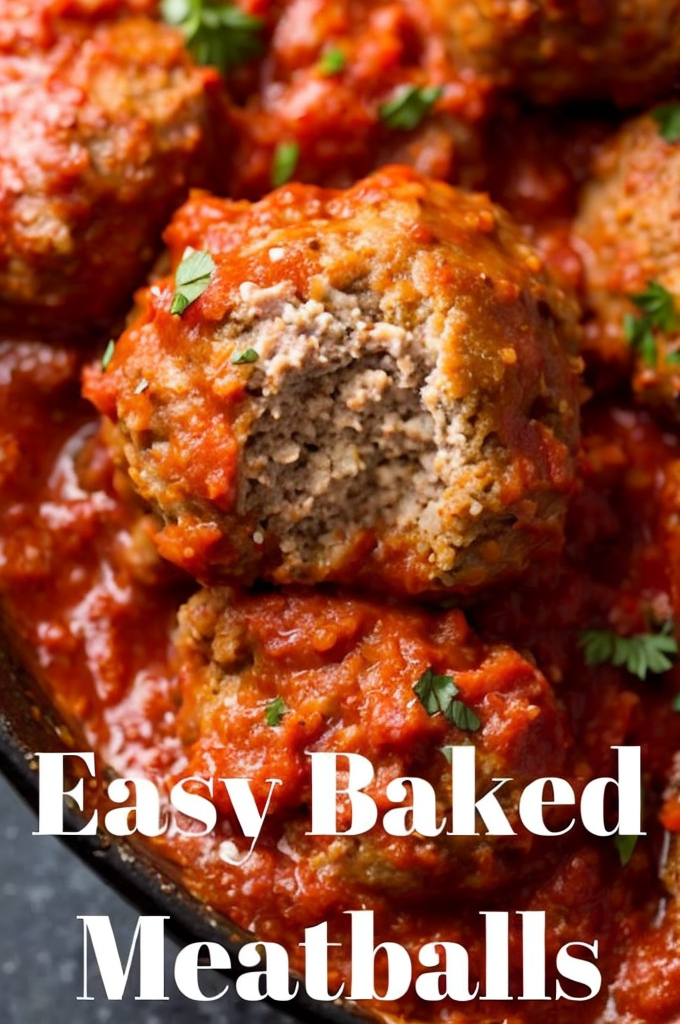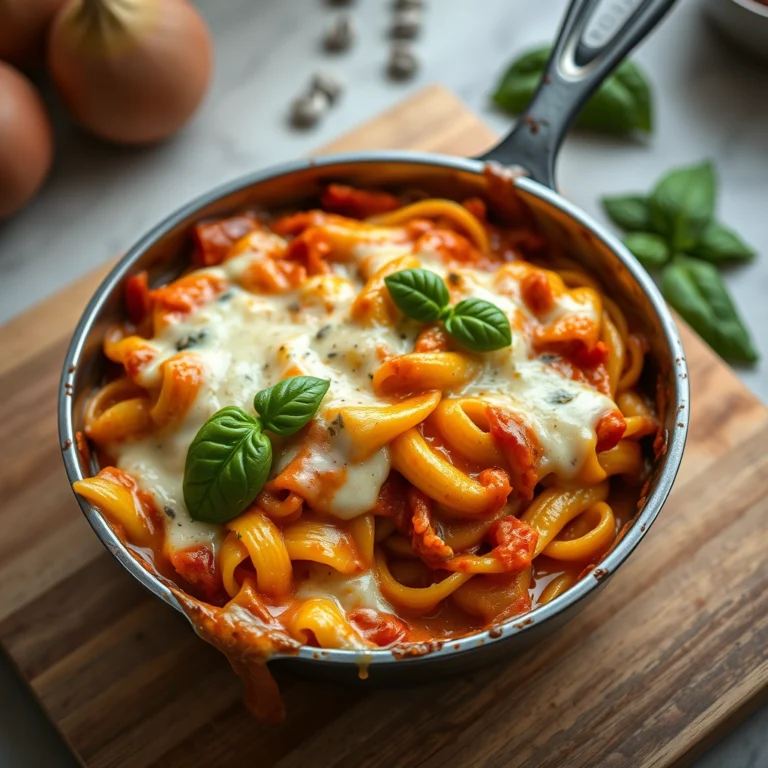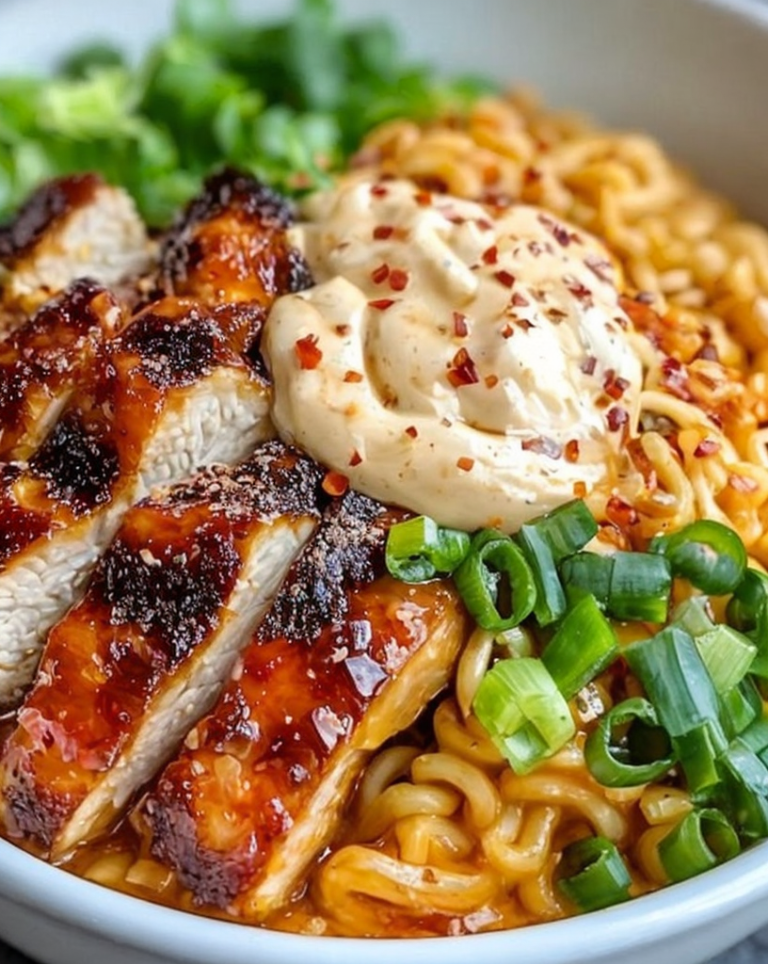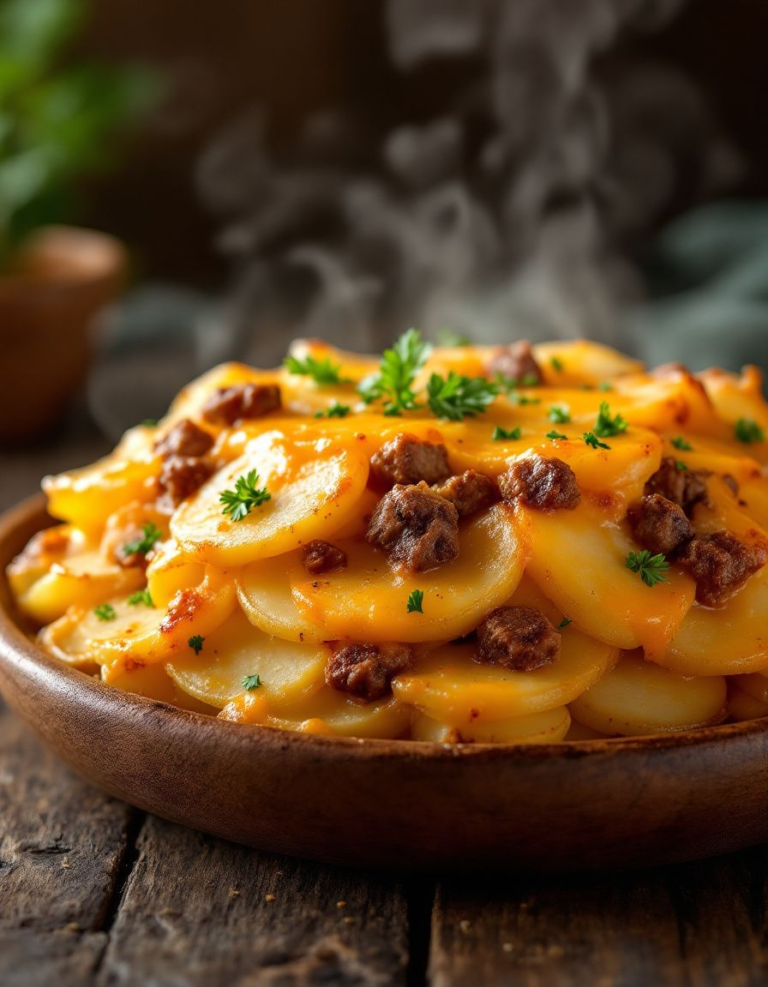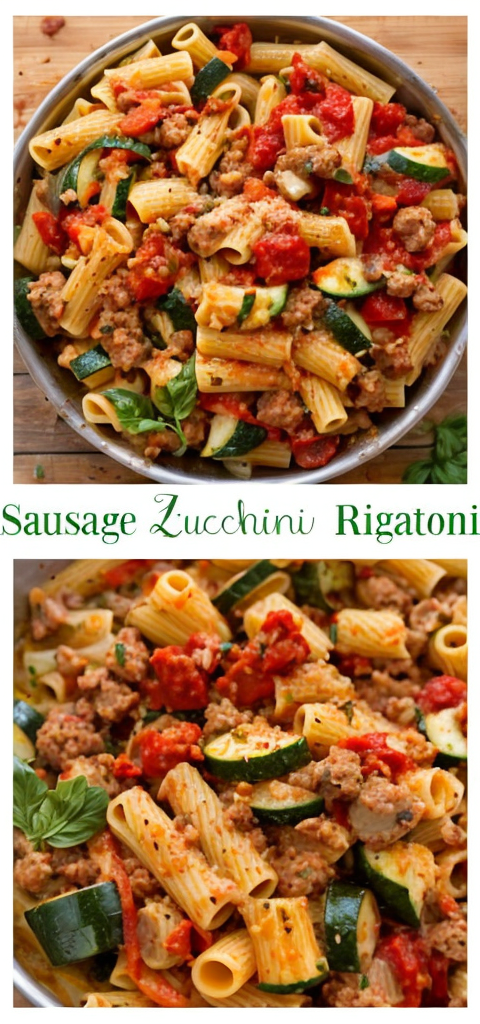Easy Baked Meatballs – Family Favorite Marinara Sauce
Easy Baked Meatballs – Family Favorite Marinara Sauce: The Perfect Comfort Food
Imagine sitting down with your family, the comforting aroma of Easy Baked Meatballs with Family Favorite Marinara Sauce wafting through the air. This simple yet satisfying dish combines tender, juicy baked meatballs with a rich marinara sauce that will make your taste buds sing. Perfect for a busy weeknight or a cozy weekend dinner, this recipe is bound to become a staple in your household. Not only is it easy to prepare, but the flavors meld beautifully, creating an unforgettable meal that everyone will love.
Baking meatballs instead of frying them offers a healthier, less messy alternative while still achieving that desired savory crust. The Family Favorite Marinara Sauce is hearty and robust, brimming with Italian herbs, garlic, and ripe tomatoes that develop into a thick, luscious sauce. Whether you’re serving these meatballs over pasta, in a hearty sandwich, or simply with a side salad, they’ll seamlessly fit into any meal plan, providing satisfaction and warmth to every bite.
Quick Recipe Highlights
- Flavor Profile: Savory, herby, and slightly tangy, with a touch of sweetness balancing out the acidity of the tomatoes perfectly.
- Texture: The meatballs are tender inside with a slight crisp on the outside, while the sauce is smooth and hearty.
- Aroma: The enticing smell of garlic, basil, and other Italian herbs fills your kitchen, making it a warm and inviting space.
- Visual Appeal: The vibrant red sauce accompanied by golden brown meatballs is not only tasty but beautifully eye-catching.
- Skill Level Needed: Beginner to intermediate; this recipe involves basic cooking techniques and is approachable for all skill levels.
- Special Equipment: A large mixing bowl, baking sheet, and a medium saucepan are all you need to bring this meal to life.
Recipe Overview
- Difficulty Level: Easy. Perfect for beginners and those looking for a straightforward recipe that doesn’t compromise on flavor.
- Category: Main course that can also double as a scrumptious appetizer when served with fresh crusty bread.
- Cuisine: Italian-inspired, bringing the beloved tastes of Italy into your home with ease.
- Cost: Economical, using pantry staples, everyday spices, and budget-friendly ingredients, keeping your wallet in check.
- Season: Ideal for all seasons, offering warmth in the winter and a delightful meal in the summer.
- Occasion: Versatile enough for family dinners, parties, or casual gatherings with friends.
Why You’ll Love This Recipe
The taste and texture of these Easy Baked Meatballs with Family Favorite Marinara Sauce are unbelievable. The blend of spices, combined with fresh ingredients, creates a mouthwatering harmony that entices you back for more. The simplicity of baking instead of frying keeps the meatballs moist while allowing for consistent cooking results every time.
Convenience is a major factor to love this recipe. With minimal prep and cooking time, you can throw together a delicious meal in less than an hour. This makes it perfect for those busy evenings when cooking can feel daunting. Plus, the use of baking allows you to attend to other tasks without much fuss.
Nutritionally, this recipe packs in proteins from the meatballs, essential vitamins from the tomatoes, and antioxidants from fresh herbs. By opting for baking instead of frying, you reduce unnecessary oils and fats, making this dish a healthier alternative.
Sharing this dish socially makes it an entertainer’s dream. The robust flavors and beautiful presentation make these meatballs a delight to serve at parties and gatherings, ensuring compliments from every guest.
Furthermore, this recipe’s ingredients are accessible and affordable, making it a cost-effective option for feeding a family or group. The elements of the dish can be easily scaled or altered, ensuring it fits a variety of dietary needs and preferences while keeping your budget intact.
Historical Background and Cultural Significance
The meatball is a timeless dish, with roots tracing back to different cultures worldwide, yet it is the Italian rendition that stands most prominent today. Historically, meatballs were created as a way to use leftover meat, transforming them into a delicious and satisfying meal with the addition of breadcrumbs and spices.
Culturally, meatballs hold a special place in Italian cuisine. Known in Italy as “polpette,” they differ significantly from American versions, often smaller and served without sauce as part of the main course. However, the Italian-American tradition of pairing meatballs with marinara has become beloved over time.
The evolution of meatballs within global cuisines has led to numerous variations, each reflecting the local flavors and traditions of their respective regions. This Italian-inspired version pairs classic ingredients to deliver a taste that echoes the beloved comfort of Italian homestyle cooking.
Regional variations of meatballs exist, reflecting the diverse range of spices, cooking methods, and food traditions from around the world. From Swedish meatballs in creamy sauce to spicy Moroccan versions, the adaptability and flavor diversity of meatballs make them a global culinary staple.
Ingredient Deep Dive
Starting with the ground meat, often a mixture of beef and pork, it’s crucial for achieving moist, flavorful meatballs. Italian cooking traditionally uses meats like veal, adding a richness to the dish. The choice of meat drastically impacts flavor and texture, offering different nutritional benefits and selecting lean mixes decreases calorie content.
Breadcrumbs serve as a critical binding agent in this recipe, contributing to the meatballs’ desirable texture, while absorbing some of the cooking juices, ensuring every bite is bursting with taste without being overly dense. Whole grain varieties can enhance health benefits, offering added fiber as well.
Fresh herbs like basil and parsley are aromatic and flavorful, infusing the sauce and meat with garden-fresh reality. Opt for freshly picked when possible, washing them well and storing them in a sealed container for maximum preservation. If fresh herbs are unavailable, dried alternatives make suitable substitutes.
Tomatoes are the star of the marinara sauce, used to create a rich, acidic base that is the hallmark of traditional Italian cooking. Selecting high-quality, ripe tomatoes or canned San Marzano tomatoes delivers the best flavor profile. Storage in a cool, dark place keeps them fresh, while freezing prepared sauce extends usability.
Common Mistakes to Avoid
- Overmixing the meatball mixture can result in tough, dense meatballs. Stir just until combined.
- Using overly lean meat can lead to dry results. Aim for a mix with 10-15% fat content for juicy meatballs.
- Skipping the resting time can lead to meatballs that fall apart during cooking.
- Overcrowding the baking sheet can prevent even cooking and browning.
- Neglecting to preheat the oven often causes uneven cooking and uncertain results.
- Using dry herbs instead of fresh without adjusting measurements can overpower the dish.
- Not tasting the marinara sauce for seasoning may leave it bland. Adjust to your flavor preference.
- Skipping the simmering stage limits the depth of flavor in the sauce.
- Ignoring portion sizes on seasoning can lead to overly salty or bland meatballs.
- Failing to let the sauce cool slightly before serving may result in runny presentations.
Essential Techniques
One fundamental technique for this recipe is ensuring ingredients are mixed gently, never overworking ground meats, which helps maintain tender results. Visual cues, like a uniformly mixed but not compact mass, indicate success.
Baking the meatballs rather than frying reduces fat content and enhances ease. Utilize a preheated oven and spread out meatballs in an even layer to ensure uniform browning. Using parchment or a lightly oiled baking sheet aids in easy cleanup.
Achieving a balanced marinara sauce begins with sautéing garlic and onions to develop the base flavor. Simmering the sauce allows the spice blend to meld, crucial for achieving authentic Italian taste. A sauce that thickens slightly while maintaining a vibrant red hue and releasing rich aromas indicates readiness.
Pro Tips for Perfect Easy Baked Meatballs
Ensure consistency in meatball size to promote even cooking by using a scoop or measuring spoon. A uniform size ensures all meatballs are perfectly cooked simultaneously.
Incorporating a panade, which is bread soaked in milk or water, enhances moisture retention in the meatballs, making them tender and juicy. Integrate it gently into the mix for the best results.
Bake meatballs atop a wire rack on a baking sheet to let fat drain away, achieving an irresistibly savory crust around each one while keeping the interior succulent.
Developing the marinara sauce flavor is essential, so always use fresh tomatoes or high-quality canned alternatives with minimal additives. Fresh basil added just before serving can inject a burst of freshness into the dish.
Experiment by adding grated Parmesan or Pecorino Romano cheese into the meatball mixture for a burst of salty richness, elevating the flavor profile.
For added texture, consider incorporating toasted pine nuts or slivered almonds into the mix. This adds a delightful crunch that contrasts beautifully with the tender meat.
Variations and Adaptations
Regional variations can incorporate spices or additions like fennel or roasted red peppers into the sauce. Changing meats, using combinations like lamb or turkey, adds nuanced international flavors.
Consider seasonal adaptations, such as incorporating freshly grated summer zucchini into the mixture, which injects added moisture and a dose of vegetables, or folding in winter root vegetables for a richer dish.
For dietary modifications, replace breadcrumbs with almond flour for a gluten-free alternative, or use plant-based meat substitutes for a vegan version, ensuring to season adequately to preserve flavor.
Experiment with flavor variations, such as adding sun-dried tomatoes or anchovy paste to the sauce for boldness. Adjust textures by altering the size of chopped vegetables for a chunkier or smoother sauce.
For exquisite presentation alternatives, consider serving meatballs in a shallow dish with a sprinkle of freshly grated Parmesan, a scattering of chopped fresh herbs, and a drizzle of high-quality olive oil to finish.
Serving and Presentation Guide
Master plating techniques by stacking meatballs artfully in a pyramid, drizzling the sauce over them strategically to highlight color contrasts. Implement garnishing with fresh basil leaves or microgreens for a vibrant touch.
For traditional accompaniments, serve over a bed of spaghetti, adorned with freshly grated cheese, using a fork and spoon for elegant swirls, reminiscent of classic Italian presentations.
Modern serving suggestions include arranging meatballs on skewers for easy handling during events, served with a ramekin of sauce for dipping. Alternatively, serve with garlic crostini for a delightful appetizer.
Temperature considerations are key with this dish; serving too hot can mask flavors, while cooled meatballs may lack luster. Aim for slightly warming the dish just before serving to bring out the best aroma and texture.
Portion control tips ensure each serving is satisfying yet manageable, with typically 3 to 4 meatballs per portion alongside appropriate sides like salad or pasta to balance the meal.
Wine and Beverage Pairing
Pair these meatballs with a robust, full-bodied red wine like Chianti or Barolo, which complements the acidity and richness of the tomato-based sauce, enhancing the overall dining experience.
For non-alcoholic alternatives, a well-brewed iced tea flavored with lemon or a sparkling mineral water with a twist of lime offers a cleanse to the palate, balancing the rich flavors.
Coffee or tea pairings, often an afterthought, can follow this meal elegantly, with a fresh espresso punctuating the conclusion of a delightful Italian-inspired dinner. Consider offering herbal teas for guests preferring milder options.
Temperature considerations for beverage service are crucial. Serve wines at room temperature, while sparkling alternatives should be chilled. Ensure teas are served hot to contrast the savory nature of the meal.
Serving suggestions include pre-pouring red wines to allow aeration, enhancing aroma and flavor, and serving sparkling waters in tall, elegant glasses with garnish for added appeal and sophistication.
Storage and Shelf Life
Store leftover meatballs in an airtight container in the refrigerator for up to three days. This maintains freshness while preventing odors from contaminating other foods.
For optimal preservation, freeze cooked meatballs and sauce in separate containers. This allows for better texture maintenance when reheating and extends shelf life up to three months.
Temperature requirements in fridge storage should remain consistent, ideally between 34-40°F, to prevent bacterial growth, while freezer settings should be at 0°F or lower for long-term keeping.
Container recommendations suggest using glass or BPA-free plastic containers with tight-fitting lids. For freezing, consider vacuum-sealed bags to reduce air exposure and freezer burn risk.
Signs of spoilage include off-odors, discoloration, or a slimy texture on meatballs. Discard any elements exhibiting these traits to avoid foodborne illness.
Reheating instructions involve gently warming meatballs and sauce separately to avoid overcooking. A slow simmer on the stove or microwave reheating in short bursts maintains quality.
Make Ahead Strategies
A strategic prep timeline involves creating the meatball mixture the day before and storing it covered in the refrigerator, allowing the flavors to meld and saving time on the cooking day.
Storage between steps is simplified by keeping shaped, raw meatballs on a lined baking sheet, covered with plastic wrap, while suspending the sauce simmering until ready to serve.
Quality impact assessment is positive when planning, as resting time enhances depth of flavor in herbs and spices, or maintaining sauce texture by resting overnight before the final simmer.
Assembly tips involve baking meatballs just before serving to ensure they retain their slightly crisp texture. Simultaneous sauce reheating keeps all components fresh and satisfying.
Reheating guidelines for made-ahead meals include using the oven at a moderate temperature for even warming, or a stovetop simmer with occasional stirring to preserve moisture and flavor.
Fresh element additions, such as sprinkling freshly chopped herbs or a squeeze of lemon juice, awaken the dish after storage, offering a refreshed taste experience.
Scaling Instructions
When halving the recipe, maintain precise ingredient ratio adjustments, particularly for binding agents like eggs and breadcrumbs, to ensure the texture remains faithful to the original.
In the case of doubling or tripling, consider bulking up herbs and spices carefully to preserve balance. Increasing baking sheet space alleviates overcrowding during cooking.
Equipment adjustments may include using multiple baking sheets or a larger mixing bowl, ensuring thorough mixing without spillage, preserving efficiency.
Timing modifications for larger batch cooking may require rotating sheets in the oven to promote even browning and prevent burning due to increased heating space.
Storage considerations for scaled versions involve freezing portions separately, preventing premature spoilage or quality sacrifice while optimizing meal prep conveniences.
Nutritional Deep Dive
The nutritional macro breakdown of this dish includes proteins from the meats, healthy fats, and carbohydrates, providing balanced energy for the day. Lean meats decrease saturated fat presence, complementing heart-health benefits.
Micronutrient analysis highlights notable vitamins like Vitamin C and K from herbs and tomatoes, with essential minerals from meats enrich the nutritional profile.
Health benefits stem from the protein-rich content supporting muscle health, while the antioxidants in tomatoes promote cellular well-being by combating oxidative stress.
Dietary considerations for portion control and composition, substituting high-fat meats with lean options, or adding vegetables for volume, adhere to customizable dietary needs.
Portion analysis ensures serving sizes are both satisfying and nutrient-dense, empowering meal satisfaction without excessive caloric intake.
Weight management tips incorporate mindful eating practices, such as slowing the eating process, savoring flavors, and utilizing smaller plates to promote controlled, enjoyable consumption.
Dietary Adaptations
For gluten-free variations, replace breadcrumbs with gluten-free oats or bread alternatives, maintaining the bind expected in traditional recipes without sacrificing texture.
Dairy-free options involve skipping cheese in meatballs and instead using dairy-free milk products or broths to moisten mixtures without losing needed consistency.
Vegan adaptations replace meats with plant-based protein options such as lentils or textured vegetable protein, seasoned adequately to replicate the original taste.
Low-carb adaptations reduce breadcrumbs, doubling up on eggs as a binding agent, or using almond flour to keep carbohydrate content minimal while preserving cohesion.
Keto versions focus on high-fat meats like ground pork, minimizing carb add-ins, appreciating the fat content for enhanced flavor and adherence to ketogenic principles.
Paleo adaptations involve ensuring ingredients are of whole-food origin, steering clear of processed products, and prioritizing fresh, natural seasonings.
Low-FODMAP considerations suggest careful selection of seasonings and component foods, honoring dietary restrictions while maintaining flavor integrity.
The Recipe
Easy Baked Meatballs
Serves: 6
Prep Time: 15 mins
Cook Time: 30 mins
Total Time: 45 mins
Kitchen Equipment Needed
- Large mixing bowl
- Baking sheet
- Medium saucepan
- Wire rack
Ingredients
- 1 lb ground beef
- 1 lb ground pork
- 1 cup breadcrumbs
- 2 eggs
- 1/2 cup grated Parmesan cheese
- 2 cloves garlic, minced
- 1/4 cup chopped parsley
- Salt and pepper to taste
- 2 tablespoons olive oil
- 28 oz can crushed tomatoes
- 1 tablespoon tomato paste
- 1 teaspoon dried oregano
- 1 teaspoon dried basil
Directions
- Preheat the oven to 400°F (200°C). Line a baking sheet with parchment paper and place a wire rack on top.
- In a large mixing bowl, combine ground beef, pork, breadcrumbs, eggs, Parmesan cheese, half of the minced garlic, parsley, salt, and pepper. Mix gently until combined.
- Form the mixture into golf ball-sized meatballs and place them on the prepared wire rack, ensuring they have enough space between each.
- Bake in the preheated oven for 20-25 minutes, until meatballs are golden and cooked through.
- While the meatballs bake, heat olive oil in a medium saucepan over medium heat. Add the remaining garlic and sauté until fragrant.
- Add crushed tomatoes, tomato paste, oregano, basil, salt, and pepper. Stir to combine, bringing to a gentle simmer.
- Simmer for 10-15 minutes, letting the flavors meld together.
- Add baked meatballs to the sauce, stirring gently to coat.
- Simmer for an additional 5 minutes to allow the meatballs to absorb some sauce flavors.
- Serve hot, with additional parsley or grated cheese as garnish if desired.
Recipe Notes
- Adjust seasoning to taste, as preferences for saltiness and herbs can vary greatly.
- For a spicier kick, consider adding red pepper flakes to the sauce during its simmering stage.
- Leftovers can be stored in an airtight container for up to three days or frozen for up to three months.
Troubleshooting Guide
Texture issues, such as dry meatballs, can be resolved by adjusting fat content within the meat mix or ensuring moisture-rich ingredients are balanced during mixing.
Flavor balance challenges should assess salt, herbs, and tomato acidity levels to enhance flavor depth without overpowering. Taste adjustments prior to final simmer make a significant difference.
Temperature problems, whether undercooked internals or overbrowned exteriors, hinge on oven calibration and monitoring bake timings. Consider rotating sheets for uniform heating.
Equipment challenges, such as insufficient baking space, can be remedied by dividing batches to avoid overcrowding, promoting consistent cooking.
Ingredient substitutions, notably with fresh versus dried herbs, demand measurement adaptation, ensuring flavor intensity aligns with intended outcome.
Timing concerns become manageable with precise pre-planning. Advanced preparation simplifies cooking, enabling seamless integration of flavors and textures.
Recipe Success Stories
Engaging with readers, exploring their variations on this recipe, enriches community understanding and creates a tapestry of interpretations ranging from additional veggie incorporation to cheese blends, showcasing the adaptability of foundational recipes.
Celebrated adaptation stories often revolve around personal touches like the addition of chili or exotic spices, infusing unique twists while maintaining traditional cores. Feedback indicates these changes invigorate the recipe without abandoning its comforting origin.
Reader suggestions frequently consider ingredient accessibility or adapt to cultural preferences, displaying universal appreciation for carefully crafted meals melded with inspiration from diverse kitchens.
Photography tips within the community emphasize natural lighting and artistic plating, revealing a shared commitment to showcasing food in its most appetizing form, creating a visual testament to culinary achievement.
Frequently Asked Questions
Can I prepare meatballs in advance?
Yes, you can shape meatballs and store them raw in the refrigerator a day before baking. This can enhance flavor by allowing ingredients to meld. Ensure they are stored on a lined tray and covered with film to maintain freshness.
What should I serve with these meatballs?
The versatility of this recipe shines through in its accompaniment. Serve with spaghetti, atop toasted bread as sliders, or along a fresh green salad. Garlic bread also makes an excellent partner.
Can I use only beef or pork?
Yes, selecting only one type of meat is completely acceptable. Adjust seasoning slightly for flavor balance, as pure beef may have less fat, needing additional herbs or olive oil for moisture.
What’s the difference between frying and baking meatballs?
Frying imparts a richer, browned crust while potentially infusing more oil into the meatballs. Baking offers a healthier option, lightly browning while maintaining moisture and minimizing mess.
How can I make these vegetarian?
An array of vegetarian substitutes can create meatballs, such as lentils, quinoa mixtures, or pre-made plant-based alternatives. Season with herbs and spices to parallel the original flavor.
Is it necessary to use breadcrumbs?
While breadcrumbs aid in cohesiveness and texture, alternatives like crushed crackers or oats serve well. Removal requires compensating for structural integrity via other binders such as egg.
What type of tomatoes should be used for the sauce?
High-quality San Marzano canned tomatoes provide superior texture and flavor, ideal for a classic marinara. Fresh ripe tomatoes, peeled, are also viable. Select based on availability and preference.
How do I freeze and reheat meatballs?
Once cooled, place meatballs in a single layer on a baking sheet to freeze arbitrarily, then transfer to a sealed container. Reheat in a moderate oven or covered saucepan for best texture retention.
Can I substitute the cheese?
Cheese selection often drives flavor, so use Pecorino Romano for a sharper taste or nutritional yeast for a dairy-free alternative, ensuring flavor augmentation matches desired outcomes.
What if my sauce tastes sour?
A small addition of sugar or a drizzle of honey often balances an overly tart marinara sauce, countering acidity without altering the fundamental flavor intent.
Are fresh herbs necessary?
Fresh herbs undeniably impact flavor, but dried varieties remain acceptable when used appropriately (typically at 1/3 volume of fresh amounts). Remember to adjust to taste before serving.
Additional Resources
Related recipes often explored alongside baked meatballs include marinara-based pastas, showcasing methods for homemade noodle preparation, or alternative protein varieties like turkey balls offering different nutritional canvases.
Technique guides highlight important kitchen skills such as proper meat mixing to avoid dense meatballs or ways to layer flavor in sauces, gradually impart knowledge through easy-to-follow steps and tips.
Ingredient information extends from recognizing the quality of meat cuts to understanding seasonal herb selection. This encourages a deeper appreciation for the food’s origin and its journey to table.
Equipment recommendations surface, especially for home cooks seeking optimal meatball tools, emphasizing utility items like measuring scoops that aid symmetry or specifically coated pans limiting sticking risk.
Seasonal variations guide seasonal farm-to-table practices, cooking within local offerings’ natural cycles and promoting freshness, aligning culinary creations with naturally available flavor profiles.
Join the Conversation
Social media sharing connects cooks worldwide, exchanging ideas and personal interpretation of Easy Baked Meatballs, fostering collective creativity and celebrating culinary triumphs within an inclusive community setting.
Photography tips thrive in diverse online platforms, sparking discussions on lighting techniques, the inclusion of natural food props, or styled plating, collectively enhancing visual storytelling capabilities.
Recipe reviews play a role in iterative improvement and community acknowledgment, valuing feedback as a powerful tool for recipe refinement, with insights shared openly benefiting collective culinary progress.
Community engagement through comments or virtual gatherings encourages dialogue among food enthusiasts, nurturing a welcoming space for healthy debate, collective learning, and shared passion for well-crafted meals.
Recipe variations showcase individuality, championing creativity, and extension beyond the original script, liberating cooks to explore cultural influences or personal preferences openly, enriching the communal fabric of food culture.

